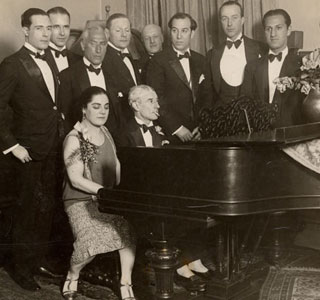BPO Votes Blue
by Jan Jezioro
Gershwin and Ravel featured in a one-night-only performance

Making her Kleinhans debut, guest pianist Anne-Marie McDermott will perform the Ravel Concerto in the first half of the program and then return to close the evening with a performance of Gershwin’s enormously popular Rhapsody in Blue. The program opens with Gershwin’s love letter to France, An American in Paris, and includes the BPO premiere performance of the Sinfonietta by French composer Francois Poulenc.
American pianist, Anne-Marie McDermott, began playing the Piano at the age of five. A winner of the Young Concert Artists Auditions, she was also the recipient of the Avery Fisher Career Development Award among other prestigious awards. Her playing has been widely praised for its boldly dramatic style as well as for her ability to maintain “an admirable clarity of line.” Besides performing with many major American orchestras, McDermott has also developed a strong reputation as a solo recitalist, offering programs that have included all of the Prokofiev piano sonatas. An artist member of the Chamber Music Society of Lincoln Center, McDermott has appeared across the country in recitals with violinist Nadja Salerno-Sonnenberg. Gramophone magazine strongly recommended her new recording of the complete works for piano and orchestra by Gershwin, just released in England, with the Dallas Symphony under conductor Justin Brown, for its performances that “fly off the page with verve and confidence.”
The music of George Gershwin epitomizes the Jazz Age of the 1920s. Rising from an impoverished Lower East Side childhood, Gershwin was already a successful Tin Pan Alley songwriter when he met Paul Whiteman, a classically trained musician who led a popular jazz influenced dance band that recorded several of Gershwin’s song tunes. After a successful tour of England in 1923, Whiteman planned a major concert for his band featuring what he called “Symphonic Jazz,” his attempt to justify jazz to highbrow circles. He asked Gershwin to compose a work for a concert that he would present in Aeolian Hall on February 12, 1924. Legend has it Gershwin forgot about the request until he read an article about the concert in the Herald Tribune on January 4, 1924. In his own account, Gershwin writes that he started composing the piece on a train trip to Boston, where “inspired by its steely rhythms…I suddenly heard—even saw on paper—the complete construction of the Rhapsody, from beginning to end.” In any case, the piano score for Rhapsody in Blue was composed in a few short weeks, with Ferde Grofé doing the orchestration for jazz band. While the rest of the concert featured miscellany that was neither modern nor jazz, Gershwin’s performance of Rhapsody in Blue was a huge public, if not critical, success. The work has been subsequently re-orchestrated for symphony orchestras several times, and been performed in an almost bewildering number of styles and forms. Roundly criticized at times for not being jazz as well as for not being a truly symphonic work, somehow Rhapsody in Blue, a work that defies classification, has survivedl, remaining a great audience favorite.
In an interesting side note, the only other time that the BPO presented the work on a Classics program, as opposed to a Pops concert, was in 1951, when the pianist was Oscar Levant, Gershwin’s friend, and the first person to play the work other than the composer.
“Personally I find jazz most interesting: the rhythms, the way the melodies are handled, the melodies themselves. I have heard of George Gershwin’s works and I find them intriguing,” Ravel wrote, shortly before his American tour where he first met Gershwin at a birthday party given for him by French Canadian singer Eva Gauthier on March 7, 1928. Gershwin performed Rhapsody in Blue on that occasion in such a way, according to the hostess, that Ravel was “dumbfounded.” She also writes, perhaps apocryphally, that Ravel turned down a request from Gershwin to study with him, since if he did so he “might lose that great melodic spontaneity and write bad Ravel.” It has been suggested that Ravel did eventually give Gershwin a composition lesson, in his own jazz-influenced G major Piano Concerto, where the older composer “provides Gershwin with a lesson about economy of means in form and orchestration—a lesson that Ravel could have taught many other composers.” This Saturday evening, members of the audience can draw their own conclusions.
For more information, visit www.bpo.org or call 885-5000.
blog comments powered by Disqus|
Issue Navigation> Issue Index > v7n48: Retreat! (11/27/08) > BPO Votes Blue This Week's Issue • Artvoice Daily • Artvoice TV • Events Calendar • Classifieds |









 Current Issue
Current Issue